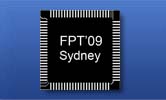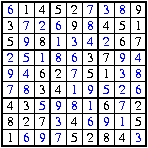 |
 |
 |
| IN THIS SECTION |
| Design Competition |
| Background |
| Details |
| Benchmarks |
| Design Submission |
| Contact Us |
Back to... |
| FPT'09 Home |
| QUICK LINKS |
Sudoku is a logic puzzle that has gained massive popularity in recent years. Today, you can find daily Sudoku puzzles posted in major newspapers around the globe.
Sudoku is a simple, yet addictive, logic puzzle. There is a wealth of information on the Internet about Sudoku, including daily puzzles, solvers, and even mathematical analyses of the puzzle. A few great sites that offers Sudoku information include Wikipedia and Web Sudoku, which also include an online tutorial.
A typical Sudoku puzzle is shown below:

Each Sudoku puzzle consists of a 3-by-3 grid of boxes. Each box itself is a 3-by-3 grid of cells. Therefore, there is a total of 81 cells. Some of them, called givens, are filled in when the puzzle is given to you.
The rule to solve a Sudoku puzzle is simple: Fill in all the cells with a number from 1 to 9 such that no number appears more than once in a row, a column, or a box. For example, the solution to the above sample is shown below:


For this competition, you will be designing an FPGA-based Sudoku solver that can solve puzzles for 3 ≤ N ≤ 15.